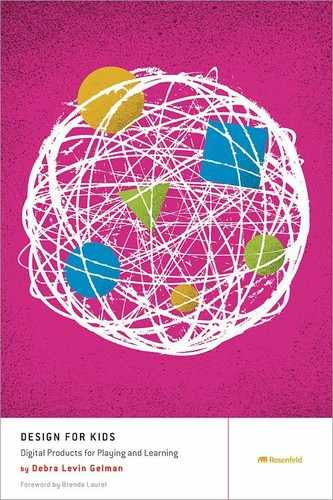HOW TO USE THIS BOOK
Who Should Read This Book?
This book is for anyone interested in designing digital experiences for kids, whether it’s creating a website, a game, a mobile app, or a piece of software.
You don’t need to be a designer or a developer to understand this book, although it does assume some basic knowledge of design terminology.
What’s in This Book?
This book is divided into three sections.
The first section, Chapters 1, 2, and 3, talks about why kids are fabulous, crazy, infuriating, and delightful to design for. It covers the basics of cognitive development, provides a framework for design, and draws connections between designing for kids and designing for other audiences.
Chapter 1, “Kids and Design,” describes the evolution of websites for kids, from the early days of the Internet through today.
Chapter 2, “Playing and Learning,” defines a framework for designing for child audiences and explains how principles we use to design for kids can be applied to adult audiences as well.
Chapter 3, “Development and Cognition,” dives into the stages of children’s cognitive growth and highlights key aspects of child development that are important to consider when designing for kids.
The second section, Chapters 4–9, provides detailed information on design patterns, principles, tools, and techniques to use with kids, as well as ways to conduct effective user research and testing.
Chapter 4, “Kids 2–4: Little People, Big Expectations,” provides tips and techniques for kids ages 2–4. It focuses on designing for non-readers, using color judiciously, and creating an appropriate visual hierarchy, among other topics.
Chapter 5, “Kids 4–6: The Muddy Middle,” outlines approaches for designing for 4–6-year-olds, including social design, levels of feedback, and creative exploration.
Chapter 6, “Kids 6–8: The Big Kids,” talks about what you need to know when designing for 6–8-year-olds. Topics include progression and leveling up, establishing rules for play, and self-expression.
Chapter 7, “Kids 8–10: The ‘Cool’ Factor,” covers 8–10-year-olds, and includes issues like failure, complexity, advertising, and identity.
Chapter 8, “Kids 10–12: Growing Up,” discusses the nuances involved in designing for children ages 10–12, who, despite being cognitively mature, still require some special treatment when it comes to digital experiences.
Chapter 9, “Design Research,” explores research techniques for kids of different ages. It includes information about recruitment, release forms, and parental involvement.
The third section, Chapters 10 and 11, brings all the information from the first two sections together, providing everything you need to create a great digital experience for children.
Chapter 10, “An App for All Ages,” demonstrates how design patterns evolve for kids of different ages. You’ll see how a basic video-viewing app designed for an audience of 2–4-year-olds progresses into a complex entertainment repository for 10–12-year-olds with playlists, favorites, and sharing.
Chapter 11, “Putting It All Together,” provides information about the business aspects of designing for kids, such as making your app available for download and getting your website up and running.
Throughout the book, you’ll find interviews and case studies from both kids and industry experts.
What Comes with This Book?
This book’s companion website (![]() rosenfeldmedia.com/books/design-for-kids/) contains a blog and additional content. The book’s diagrams and other illustrations are available under a Creative Commons license (when possible) for you to download and include in your own presentations. You can find these on Flickr at www.flickr.com/photos/rosenfeldmedia/sets/.
rosenfeldmedia.com/books/design-for-kids/) contains a blog and additional content. The book’s diagrams and other illustrations are available under a Creative Commons license (when possible) for you to download and include in your own presentations. You can find these on Flickr at www.flickr.com/photos/rosenfeldmedia/sets/.
